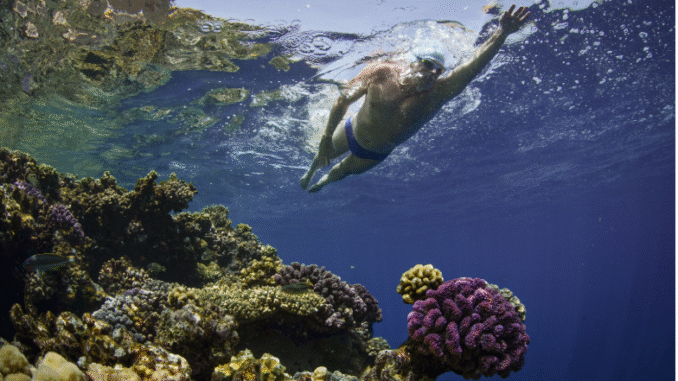
- Endurance swimmer and UN Patron of the Oceans, Lewis Pugh, has swum 123 kilometres across the Red Sea to raise awareness of the impact of climate change on corals.
- He timed the feat to coincide with COP27 and told world leaders at the UN climate summit that “every fraction of a degree matters” in terms of global warming.
- Pugh spoke to the World Economic Forum after completing his swim and explained the challenges he faced and why it’s so important coral reefs are protected.

“I was looking down at some of the most amazing coral reefs in the world. There were turtles and manta rays and sharks and small little goldfish and big parrotfish and coral in purple and green and yellow. It’s amazing. But we run the risk now of losing all of this if we carry on the way we’re going.”
So says Lewis Pugh, the endurance swimmer, who’s just become the first person ever to swim across the Red Sea, to highlight the plight of the oceans and, in particular, coral reefs, which are the “nurseries of the ocean”.
Timed to coincide with the COP27 UN climate summit in Sharm El-Sheik, Pugh, a UN Patron of the Oceans, swam 123 kilometres in 16 days from Tiran Island, Saudi Arabia and all along the coast of the tourist resort hosting the summit, to Hurghada on the opposite side of the Red Sea in Egypt.

He tackled strong winds for 10 days and encountered sharks and container ships in the shipping lanes leading to the Suez Canal, but he also swam through the Marine Protected Area of Ras Mohammed National Park.
Last year, Pugh spoke to the World Economic Forum after completing a gruelling 12-day swim across the Ilulissat Icefjord in Greenland. Here, he explains what the Red Sea Swim was like and his message to COP27 leaders.
How did the two experiences compare?
When I was swimming in the Arctic in Greenland, the water was around zero degrees centigrade. It’s unbelievably cold. And when you swim in the Red Sea, the water is incredibly hot, sometimes close to 30 degrees centigrade. The risks in the Arctic are that you’re going to get hypothermia and in the Red Sea you’re going to get the complete opposite: hyperthermia. So that was the main danger. The warm water just saps you of all your strength and energy. The views are amazing, but it actually just saps you of everything.

Why did you choose the Red Sea for your next challenge?
I see the polar regions and the coral reefs as the two ground zeros of the climate crisis: it’s just so evident. I’ve spent 35 years swimming in the world’s oceans and these are the two places where we’re seeing the climate crisis just moving so quickly. In the Arctic I’m seeing melting glaciers and the melting of the Greenland ice sheet, and less and less sea ice in the Arctic.
Leave a Reply